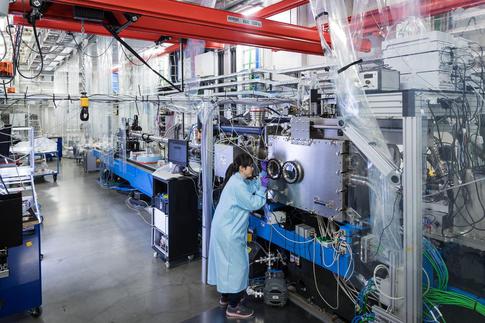XFEL: Industry collaboration reveals insights on drug target
Industry collaboration reveals insights on drug target

Scientist Yoonhee Kim at the SPB/SFX instrument
GPCRs are a family of proteins involved in mediating cell signaling and regulating sensory and physiological processes in the human body. GPCRs are an important class of therapeutic drug targets, with around 30% of current marketed drugs targeting them. Determining the atomic structure of GPCRs bound to clinical candidate molecules, however, is challenging due to the micrometer-scale size of the GPCR crystals typically obtained. Standard techniques like macromolecular X-ray crystallography cannot characterize GPCRs well because the small crystals do not diffract well at synchrotron radiation sources.
Researchers from European XFEL and Sosei Heptares have now successfully performed measurements to determine the structure of the thermostabilized human Adenosine 2A (A2A) receptor from micrometer-sized crystals. Although the structure of the A2A receptor is already known, this achievement shows that the European XFEL, which generates high energy X-ray flashes used by researchers all over the world, is well-suited to determine the atomic structures of GPCRs in general. Molecules inhibiting the A2A receptor signaling, also known as antagonists, have shown promise in the treatment of Parkinson’s disease, attention deficit hyperactivity disorder (ADHD), cancer and other diseases. By understanding the atomic details of the mechanism of action of molecules on GPCRs, pharmaceutical companies can rationally design better and more selective drugs.
“The initial analysis of the results is very promising. We collected full data sets at very high resolution from three individual experiments and we are looking forward to revealing more atomic details once the data processing is completed,” highlights Dr Tian Geng, Senior Scientist II from Sosei Heptares. “Employing A2a receptors in the experiments has successfully demonstrated the unique advantages of the European XFEL in enabling structure determination using micrometer-size crystals, which are unworkable using standard synchrotron light sources.”
“The high X-ray pulse energies as well as the hard X-ray flashes were both instrumental in the experiment. Industrial users are challenging the state-of-the-art of light sources in applied science,” underlined Dr. Adrian Mancuso, Leading Scientist of the scientific instrument, SPB/SFX, during the experiment. “These applied experiments help us to further develop the capabilities of the European XFEL and show its potential to address societally relevant global challenges.”
Dr. Mathieu Rappas, Sosei Heptares' Director of Biochemistry, said: “This is a very exciting and productive collaboration, and we are grateful for the support and deep expertise provided by the whole European XFEL SPB/SFX team. After this successful proof-of concept series of experiments, we are now looking forward to using the facility’s capabilities to investigate some of our more challenging targets."
The collaboration now intends to take advantage of European XFEL’s unique capabilities to perform time-resolved measurements on GPCRs in viscous environments. These studies could further enhance Sosei Heptares’ ability to engineer desired properties into its drug candidate molecules targeting GPCRs.
Contacts
For European XFEL:
Scientific contact:
Richard Bean
E-mail: richard.bean@xfel.eu
Tel: +49-40-8994-1905
Industrial Liaison Office
Antonio Bonucci
E-mail: ilo@xfel.eu
Tel: +49 40 8998-4773
Press contact:
Bernd Ebeling
press@xfel.eu
Tel: +49 40 8998-2020
For Sosei Heptares:
Mark Swallow, Frazer Hall, Eleanor Perkin (MEDiSTRAVA Consulting)
SoseiHeptares@medistrava.com
+44 (0)203 928 6900
About Sosei Heptares
We are an international biopharmaceutical group focused on the discovery and early development of new medicines originating from our proprietary GPCR-targeted StaR® technology and structure-based drug design platform capabilities. We are advancing a broad and deep pipeline of novel medicines across multiple therapeutic areas, including neurology, immunology, gastroenterology and inflammatory diseases.
We have established partnerships with some of the world’s leading pharmaceutical companies and multiple emerging technology companies, including AbbVie, AstraZeneca, Genentech (Roche), GSK, Kallyope, Neurocrine Biosciences, Novartis, Pfizer, Takeda and Verily. Sosei Heptares is headquartered in Tokyo, Japan with corporate and R&D facilities in Cambridge, UK.
“Sosei Heptares” is the corporate brand and trademark of Sosei Group Corporation, which is listed on the Tokyo Stock Exchange (ticker: 4565). Sosei, Heptares, the logo and StaR® are trademarks of Sosei Group companies.
For more information, please visit https://www.soseiheptares.com/
LinkedIn: @soseiheptaresco | Twitter: @soseiheptaresco | YouTube: @soseiheptaresco
